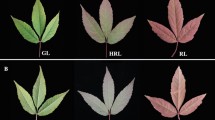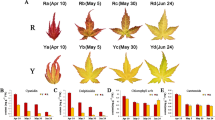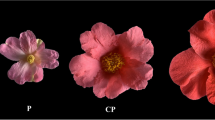Abstract
Cymbidium ensifolium L. is an economically important terrestrial orchid. Leaf color is a key horticultural trait with aesthetic and ornamental significance. However, the molecular basis of leaf color change in C. ensifolium remains to be fully understood. Here, different color leaves of C. ensifolium were collected and classified into two groups, namely, leaf buds that appear red in the juvenile stage (RL) and those that transform green in the mature stage (GL). Significantly higher anthocyanin content was observed in RL than GL. RNA-seq data showed a total of 3955 differentially expressed unigenes (DEUs) were screened, and 381 differentially accumulated metabolites (DAMs) were detected by metabolome analysis in RL vs GL. Further analysis revealed that the anthocyanin biosynthesis pathway (ko00942) is essential for leaf color change. Cyanidin-3-O-glucoside, petunidin-3-O-(6″-O-p-coumaroyl) rutinoside, and peonidin-3-O-glucoside were identified as key anthocyanins affecting leaf color change. Meanwhile, we identified key structural unigenes associated with leaf color change, including CHS, CHI, DFR, F3H, F3′H, and ANS. Correlation analysis revealed 77 DEUs associated with transcription factors to exhibit strong correlations with both DEUs and DAMs involved in anthocyanin biosynthesis. Our study identifies the important metabolic and functional role of the anthocyanin biosynthesis pathway in C. ensifolium leaf color change.





Similar content being viewed by others
Data availability
All the raw data are available in the China National Genebank (CNGB, https://db.cngb.org/cnsa/) with the accession number CNP0004200.
References
Ahmad S, Chen JL, Chen GZ, Huang J, Zhou YC, Zhao K, Lan SR, Liu ZJ, Peng DH (2022) Why black flowers? An extreme environment and molecular perspective of black color accumulation in the ornamental and food crops. Front Plant Sci 13:885176–885187. https://doi.org/10.3389/fpls.2022.885176
Ai Y, Li Z, Sun WH, Chen J, Zhang DY, Ma L, Zhang QH, Chen MK, Zheng QD, Liu JF, Jiang YT, Li BJ, Liu X, Xu XY, Yu X, Zheng Y, Liao XY, Zhou Z, Wang JY, Wang ZW, Xie TX, Ma SH, Zhou J, Ke YJ, Zhou YZ, Lu HC, Liu KW, Yang FX, Zhu GF, Huang L, Peng DH, Chen SP, Lan S, Van de Peer Y, Liu ZJ (2021) The Cymbidium genome reveals the evolution of unique morphological traits. Hortic Res 8(1):255–269. https://doi.org/10.1038/s41438-021-00683-z
Albert NW, Arathoon S, Collette VE, Schwinn KE, Jameson PE, Lewis DH, Zhang H, Davies KM (2010) Activation of anthocyanin synthesis in Cymbidium orchids: variability between known regulators. Plant Cell Tissue Organ Culture (PCTOC) 100(3):355–360. https://doi.org/10.1007/s11240-009-9649-0
Bureau S, Renard CMGC, Reich M, Ginies C, Audergon J-M (2009) Change in anthocyanin concentrations in red apricot fruits during ripening. LWT Food Sci Technol 42(1):372–377. https://doi.org/10.1016/j.lwt.2008.03.010
Dunn WB, Broadhurst D, Begley P, Zelena E, Francis-McIntyre S, Anderson N, Brown M, Knowles JD, Halsall A, Haselden JN, Nicholls AW, Wilson ID, Kell DB, Goodacre R, Human Serum Metabolome C (2011) Procedures for large-scale metabolic profiling of serum and plasma using gas chromatography and liquid chromatography coupled to mass spectrometry. Nat Protoc 6(7):1060–1083. https://doi.org/10.1038/nprot.2011.335
Feng XK, Gao G, Yu CM, Zhu AG, Chen JK, Chen KM, Wang XF, Abubakar AS, Chen P (2021) Transcriptome and metabolome analysis reveals anthocyanin biosynthesis pathway associated with ramie (Boehmeria nivea (L.) Gaud.) leaf color formation. BMC Genom 22(1):684–698. https://doi.org/10.1186/s12864-021-08007-0
Fernández-García E, Carvajal-Lérida I, Jarén-Galán M, Garrido-Fernández J, Pérez-Gálvez A, Hornero-Méndez D (2012) Carotenoids bioavailability from foods: from plant pigments to efficient biological activities. Food Res Int 46(2):438–450. https://doi.org/10.1016/j.foodres.2011.06.007
Ferrer JL, Austin MB, Stewart C Jr, Noel JP (2008) Structure and function of enzymes involved in the biosynthesis of phenylpropanoids. Plant Physiol Biochem 46(3):356–370. https://doi.org/10.1016/j.plaphy.2007.12.009
Gao J, Ren R, Wei YL, Jin JP, Ahmad S, Lu CQ, Wu JQ, Zheng CY, Yang FX, Zhu GF (2020) Comparative metabolomic analysis reveals distinct flavonoid biosynthesis regulation for leaf color development of Cymbidium sinense “Red Sun.” Int J Mol Sci 21(5):1869–1885. https://doi.org/10.3390/ijms21051869
Ge W, Wang XX, Li JY, Zhu WP, Cui JT, Zhang KZ (2019) Regulatory mechanisms of leaf color change in Acer pictum subsp. mono. Front Plant Sci 62(12):793–805. https://doi.org/10.1139/gen-2019-0115
Grabherr MGHB, Yassour M, Levin JZ, Thompson DA, Amit I, Adiconis X, Fan L, Raychowdhury R, Zeng Q, Chen Z, Mauceli E, Hacohen N, Gnirke A, Rhind N, di Palma F, Birren BW, Nusbaum C, Lindblad-Toh K, Friedman N, Regev A (2011) Full-length transcriptome assembly from RNA-Seq data without a reference genome. Nat Biotechnol 29(7):644–652. https://doi.org/10.1038/nbt.1883
Han YJ, Lu MM, Yue SM, Li K, Shang FD (2021) Transcriptome and metabolome profiling revealing anthocyanin and phenolic acid biosynthetic mechanisms in sweet osmanthus pericarp. Sci Hortic 289:110489–110498. https://doi.org/10.1016/j.scienta.2021.110489
Hassani D, Fu XQ, Shen Q, Khalid M, Rose JKC, Tang KX (2020) Parallel transcriptional regulation of artemisinin and flavonoid biosynthesis. Trends Plant Sci 25(5):466–476. https://doi.org/10.1016/j.tplants.2020.01.001
Holton TA, Cornish EC (1995) Genetics and biochemistry of anthocyanin biosynthesis. Plant Cell 7(7):1071–1083. https://doi.org/10.1105/tpc.7.7.1071
Jaakola L (2013) New insights into the regulation of anthocyanin biosynthesis in fruits. Trends Plant Sci 18(9):477–483. https://doi.org/10.1016/j.tplants.2013.06.003
Kawase K, Tsukamoto Y, Saito N, Osawa Y (1970) Studies on flower color in Chrysanthemum morifolium RAMAT. I. Anthocyanins. Plant Cell Physiol 11(2):349–353. https://doi.org/10.1093/oxfordjournals.pcp.a074516
Langmead B, Trapnell C, Pop M, Salzberg SL (2009) Ultrafast and memory-efficient alignment of short DNA sequences to the human genome. Genome Biol 10(3):R25–R34. https://doi.org/10.1186/gb-2009-10-3-r25
Li B, Dewey CN (2011) RSEM: accurate transcript quantification from RNA-Seq data with or without a reference genome. BMC Bioinform 12:323–338. https://doi.org/10.1186/1471-2105-12-323
Li XB, Xiang L, Wang Y, Luo J, Wu C, Sun CB, Ming X (2013) Genetic diversity, population structure, pollen morphology and cross-compatibility among Chinese Cymbidiums. Plant Breed 133(1):145–152. https://doi.org/10.1111/pbr.12125
Li Y, Zhang ZY, Wang P, Wang SA, Ma LL, Li LF, Yang RT, Ma YZ, Wang Q (2015) Comprehensive transcriptome analysis discovers novel candidate genes related to leaf color in a Lagerstroemia indica yellow leaf mutant. Genes Genom 37(10):851–863. https://doi.org/10.1007/s13258-015-0317-y
Li BJ, Zheng BQ, Wang JY, Tsai WC, Lu HC, Zou LH, Wan X, Zhang DY, Qiao HJ, Liu ZJ, Wang Y (2020) New insight into the molecular mechanism of colour differentiation among floral segments in orchids. Commun Biol 3(1):89–101. https://doi.org/10.1038/s42003-020-0821-8
Li X, Li Y, Zhao MH, Hu YB, Meng FJ, Song XS, Tigabu M, Chiang VL, Sederoff R, Ma WJ, Zhao XY (2021) Molecular and metabolic insights into anthocyanin biosynthesis for leaf color change in Chokecherry (Padus virginiana). Int J Mol Sci 22(19):10697–10716. https://doi.org/10.3390/ijms221910697
Li WJ, Li HG, Shi LS, Shen P, Li YR (2022) Leaf color formation mechanisms in Alternanthera bettzickiana elucidated by metabolite and transcriptome analyses. Planta 255(3):59–78. https://doi.org/10.1007/s00425-022-03840-3
Lim GH, Kim SW, Ryu JA-O, Kang SY, Kim JA-O, Kim SA-O (2020) Upregulation of the MYB2 transcription factor is associated with increased accumulation of anthocyanin in the leaves of Dendrobium bigibbum. Int J Mol Sci 21(16):5653–5670. https://doi.org/10.3390/ijms21165653
Liu YF, Ma KX, Qi YW, Lv GW, Ren XL, Liu ZD, Ma FW (2021) Transcriptional regulation of anthocyanin synthesis by MYB-bHLH-WDR complexes in Kiwifruit (Actinidia chinensis). J Agric Food Chem 69(12):3677–3691. https://doi.org/10.1021/acs.jafc.0c07037
Livak KJ, Schmittgen TD (2001) Analysis of relative gene expression data using real-time quantitative PCR and the 2(-Delta Delta C(T)) Method. Methods 25(4):402–408. https://doi.org/10.1006/meth.2001.1262
Lloyd A, Brockman A, Aguirre L, Campbell A, Bean A, Cantero A, Gonzalez A (2017) Advances in the MYB-bHLH-WD Repeat (MBW) pigment regulatory model: addition of a WRKY factor and co-option of an anthocyanin MYB for betalain regulation. Plant Cell Physiol 58(9):1431–1441. https://doi.org/10.1093/pcp/pcx075
Love MI, Huber W, Anders S (2014) Moderated estimation of fold change and dispersion for RNA-seq data with DESeq2. Genome Biol 15(12):550–570. https://doi.org/10.1186/s13059-014-0550-8
Luo JR, Duan JJ, Huo D, Shi QQ, Niu LX, Zhang YL (2017) Transcriptomic analysis reveals transcription factors related to leaf anthocyanin biosynthesis in Paeonia qiui. Molecules 22(12):2186–2199. https://doi.org/10.3390/molecules22122186
Meiling S, Yueyang L, Hongduo W, Zhongming Z (2018) Extraction process of anthocyanins from husk of local-grown rice Oryza sativa L. nanyangensis in Nanyang, Henan. Chin Agric Sci Bull 34(18):71–76
Pahlavani MH, Mirlohi AF, Saeidi G (2004) Inheritance of flower color and spininess in safflower (Carthamus tinctorius L.). J Hered 95(3):265–267. https://doi.org/10.1093/jhered/esh030
Qi XY, Chen SS, Wang HD, Feng J, Chen HJ, Qin ZY, Deng YM (2022) Comparative physiology and transcriptome analysis reveals that chloroplast development influences silver-white leaf color formation in Hydrangea macrophylla var. maculata. BMC Plant Biol 22(1):345–358. https://doi.org/10.1186/s12870-022-03727-1
Qiu WW, Su WQ, Cai ZY, Dong L, Li CB, Xin M, Fang WK, Liu YQ, Wang XM, Huang ZB, Ren H, Wu ZJ (2020) Combined analysis of transcriptome and metabolome reveals the potential mechanism of coloration and fruit quality in yellow and purple Passiflora edulis Sims. J Agric Food Chem 68(43):12096–12106. https://doi.org/10.1021/acs.jafc.0c03619
Robinson GM, Robinson R (1932) A survey of anthocyanins. II Biochem J 26(5):1647–1664. https://doi.org/10.1021/acs.jafc.0c03619
Song XH, Yang QS, Liu Y, Li JJ, Chang XC, Xian LH, Zhang J (2021) Genome-wide identification of Pistacia R2R3-MYB gene family and function characterization of PcMYB113 during autumn leaf coloration in Pistacia chinensis. Int J Biol Macromol 192:16–27. https://doi.org/10.1016/j.ijbiomac.2021.09.092
Sun Y, Chen GZ, Huang J, Liu DK, Xue F, Chen XL, Chen SQ, Liu CG, Liu H, Ma H, Yuan Y, Zhang DY, Sun WH, Peng DH, Wang ZW, Lan SR, Zhao GQ, Li FT, Liu ZJ (2021) The Cymbidium goeringii genome provides insight into organ development and adaptive evolution in orchids. Ornam Plant Res 1(1):1–13. https://doi.org/10.48130/opr-2021-0010
Sunil L, Shetty NP (2022) Biosynthesis and regulation of anthocyanin pathway genes. Appl Microbiol Biotechnol 106(5–6):1783–1798. https://doi.org/10.1007/s00253-022-11835-z
Tanaka Y, Sasaki N, Ohmiya A (2008) Biosynthesis of plant pigments: anthocyanins, betalains and carotenoids. Plant J 54(4):733–749. https://doi.org/10.1111/j.1365-313X.2008.03447.x
Tang YH, Fang ZW, Liu M, Zhao DQ, Tao J (2020) Color characteristics, pigment accumulation and biosynthetic analyses of leaf color variation in herbaceous peony (Paeonia lactiflora Pall.). 3 Biotech 10(2):76–85. https://doi.org/10.1007/s13205-020-2063-3
Trapnell C, Williams BA, Pertea G, Mortazavi A, Kwan G, van Baren MJ, Salzberg SL, Wold BJ, Pachter L (2010) Transcript assembly and quantification by RNA-Seq reveals unannotated transcripts and isoform switching during cell differentiation. Nat Biotechnol 28(5):511–515. https://doi.org/10.1038/nbt.1621
Veberic R, Slatnar A, Bizjak J, Stampar F, Mikulic-Petkovsek M (2015) Anthocyanin composition of different wild and cultivated berry species. LWT Food Sci Technol 60(1):509–517. https://doi.org/10.1016/j.lwt.2014.08.033
Wang HZ, Lu JJ, Hu X, Liu JJ (2011) Genetic variation and cultivar identification in Cymbidium ensifolium. Plant Syst Evol 293(1):101–110. https://doi.org/10.1007/s00606-011-0429-z
Wang M, Chen L, Liang ZJ, He XM, Liu WR, Jiang B, Yan JQ, Sun PY, Cao ZQ, Peng QW, Lin YE (2020) Metabolome and transcriptome analyses reveal chlorophyll and anthocyanin metabolism pathway associated with cucumber fruit skin color. BMC Plant Biol 20(1):386–398. https://doi.org/10.1186/s12870-020-02597-9
Wang FF, Chen NZ, Shen SH (2021) iTRAQ-based quantitative proteomics analysis reveals the mechanism of golden-yellow leaf mutant in hybrid paper mulberry. Int J Mol Sci 23(1):127–144. https://doi.org/10.3390/ijms23010127
Want EJ, Wilson ID, Gika H, Theodoridis G, Plumb RS, Shockcor J, Holmes E, Nicholson JK (2010) Global metabolic profiling procedures for urine using UPLC-MS. Nat Protoc 5(6):1005–1018. https://doi.org/10.1038/nprot.2010.50
Wei G, Tian P, Zhang FX, Qin H, Miao H, Chen QW, Hu ZY, Cao L, Wang MJ, Gu XF, Huang SW, Chen MS, Wang GD (2016) Integrative analyses of nontargeted volatile profiling and transcriptome data provide molecular insight into VOC diversity in cucumber plants (Cucumis sativus). Plant Physiol 172(1):603–618. https://doi.org/10.1104/pp.16.01051
Xuekui W (2006) Principles and techniques of plant physiological and biochemical experiments. Higher Education Press, Beijing, pp 134–136
Yang FX, Gao J, Wei YL, Ren R, Zhang GQ, Lu CQ, Jin JP, Ai Y, Wang YQ, Chen LJ, Ahmad S, Zhang DY, Sun WH, Tsai WC, Liu ZJ, Zhu GF (2021) The genome of Cymbidium sinense revealed the evolution of orchid traits. Plant Biotechnol J 19(12):2501–2516. https://doi.org/10.1111/pbi.13676
Yang JF, Chen YZ, Xiao ZH, Shen HL, Li YH, Wang Y (2022) Multilevel regulation of anthocyanin-promoting R2R3-MYB transcription factors in plants. Front Plant Sci 13:1008829–1008845. https://doi.org/10.3389/fpls.2022.1008829
Yi DB, Zhang HN, Lai B, Liu LQ, Pan XL, Ma ZL, Wang YC, Xie JH, Shi SY, Wei YZ (2021) Integrative analysis of the coloring mechanism of red longan pericarp through metabolome and transcriptome analyses. J Agric Food Chem 69(6):1806–1815. https://doi.org/10.1021/acs.jafc.0c05023
Yu GY, Wang LG, Han YY, He QY (2012) ClusterProfiler: an R package for comparing biological themes among gene clusters. OMICS 16(5):284–287. https://doi.org/10.1089/omi.2011.0118
Zhang HL, Zhang SY, Zhang H, Chen X, Liang F, Qin HL, Zhang Y, Cong RC, Xin HB, Zhang Z (2020) Carotenoid metabolite and transcriptome dynamics underlying flower color in marigold (Tagetes erecta L.). Sci Rep 10(1):16835–16845. https://doi.org/10.1038/s41598-020-73859-7
Zhang YX, Zhang GQ, Zhang DY, Liu XD, Xu XY, Sun WH, Yu XE, Zhu X, Wang ZW, Zhao X, Zhong WY, Chen HF, Yin WL, Huang TB, Niu SC, Liu ZJ (2021) Chromosome-scale assembly of the Dendrobium chrysotoxum genome enhances the understanding of orchid evolution. Hortic Res 8(1):183. https://doi.org/10.1038/s41438-021-00621-z
Zhang DY, Zhao XW, Li YY, Ke SJ, Yin WL, Lan SR, Liu ZJ (2022a) Advances and prospects of orchid research and industrialization. Hortic Res 9:uhac220–uhac239. https://doi.org/10.1093/hr/uhac220
Zhang XY, Ruan RX, Zhao FK, Li CN, Fu QJ (2022b) Comprehensive transcriptome analysis discovers genes related to leaf color in Cymbidium ‘Sakura’ etiolated mutant. Acta Physiol Plant 45(1):12–21. https://doi.org/10.1007/s11738-022-03471-x
Zhang X, Wang J, Li PH, Sun C, Dong WX (2023) Integrative metabolome and transcriptome analyses reveals the black fruit coloring mechanism of Crataegus maximowiczii C. K. Schneid. Plant Physiol Biochem 194:111–121. https://doi.org/10.1016/j.plaphy.2022.11.008
Zhao XC, Zhang YR, Long T, Wang SC, Yang J (2022) Regulation mechanism of plant pigments biosynthesis: anthocyanins, carotenoids, and betalains. Metabolites 12(9):871–884. https://doi.org/10.3390/metabo12090871
Acknowledgements
This study was financially supported by Science and Technology Innovation Fund of Hangzhou Academy of Agricultural Sciences 2022HNCT-05.
Author information
Authors and Affiliations
Contributions
QF conceptualized the project. HM and XZ designed and performed the experiments. HM and XZ performed the bioinformatics analysis. RR and FZ contributed reagents/materials/analysis. HM, XZ, and QF prepared the manuscript. All authors read and approved the final manuscript.
Corresponding author
Ethics declarations
Conflict of interest
The authors declare no competing financial interests.
Additional information
Communicated by M. Labudda.
Publisher's Note
Springer Nature remains neutral with regard to jurisdictional claims in published maps and institutional affiliations.
Supplementary Information
Below is the link to the electronic supplementary material.
Rights and permissions
Springer Nature or its licensor (e.g. a society or other partner) holds exclusive rights to this article under a publishing agreement with the author(s) or other rightsholder(s); author self-archiving of the accepted manuscript version of this article is solely governed by the terms of such publishing agreement and applicable law.
About this article
Cite this article
Mei, H., Zhang, X., Zhao, F. et al. Integrated metabolome and transcriptome analysis provides insight into the leaf color change of Cymbidium ensifolium. Acta Physiol Plant 46, 50 (2024). https://doi.org/10.1007/s11738-024-03671-7
Received:
Revised:
Accepted:
Published:
DOI: https://doi.org/10.1007/s11738-024-03671-7




